No products in the cart.
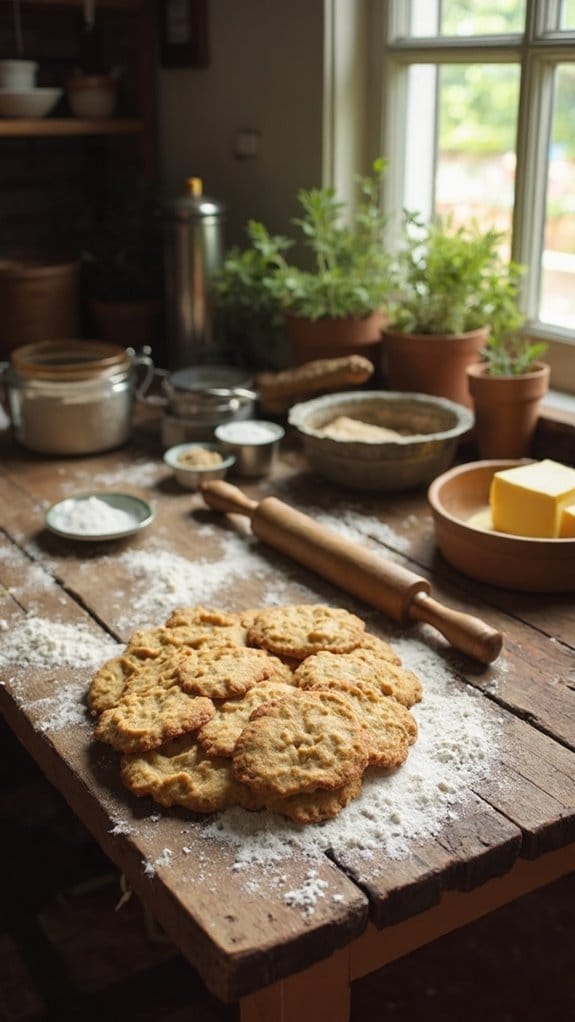
The Origins of Butter Cookies: A Sweet Tradition in American Baking
Butter cookies have a rich history that starts way back in the 1600s, mixing influences from English, Dutch, and Scotch immigrants. Isn’t it fascinating how those early cookies were luxury items, often saved for celebrations? Over time, recipes evolved, especially with Amelia Simmons’ “American Cookery” introducing her famous Butter Drop Do Cookies. As communities adapted recipes to local ingredients, cookies became symbols of warmth and hospitality. With the rise of the Industrial Revolution, mass production made these delights even more accessible. Curious about how these sweet treats have changed over time? There’s much more to explore on this delightful journey!
Contents
hide
Key Takeaways
- Butter cookies originated in the 1600s, influenced by English, Dutch, and Scotch immigrants who used simple ingredients like butter and sugar.
- Amelia Simmons’ 1796 cookbook, “American Cookery,” popularized butter cookies in America with recipes like Butter Drop Do Cookies.
- The term “cookie” derives from the Dutch word “koekje,” reflecting the early European roots of these treats.
- Regional adaptations of butter cookies emerged in Colonial America, incorporating local ingredients and flavors due to the scarcity of sugar.
- Today, butter cookies symbolize warmth and hospitality, often enjoyed during celebrations and family gatherings, fostering connections across generations.
Historical Roots of Butter Cookies
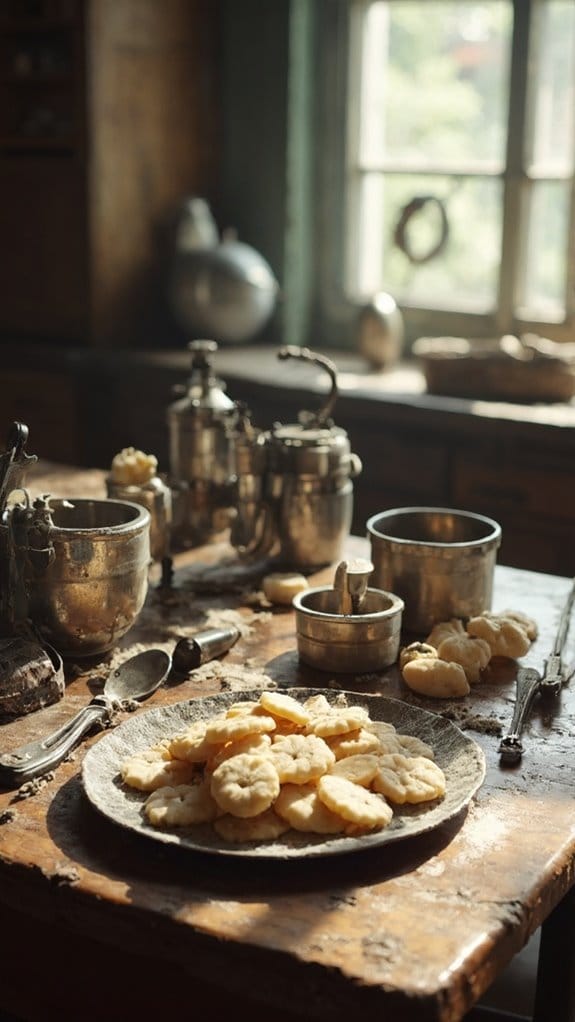
Butter cookies have a rich history that traces back to the 1600s when English, Dutch, and Scotch immigrants brought their baking traditions to America. Imagine the aroma of freshly baked cookies wafting through colonial kitchens, where these early bakers were crafting treats that mirrored their homelands.
The shortbread origins of butter cookies can be found in simple recipes that relied on basic ingredients like butter, sugar, and sometimes a touch of rose water for flavor. You might even call them “tea cakes,” especially if you found them in the Southern U.S.
Back in the day, baking was no walk in the park. Sugar was a luxury, and cookies were special treats, often reserved for celebrations. As you explore the evolution of colonial baking, you’ll see how these early recipes began to appear in cookbooks, like Amelia Simmons’ “American Cookery” published in 1796. Notably, as peanut butter cookies gained popularity during the Great Depression, they provided a more affordable treat for many families.
The geographic diversity of the U.S. introduced new ingredients, changing cookie recipes over time. Picture the expansion of railroads bringing coconuts and oranges into kitchens! Additionally, the earliest cookie-like cakes can be traced back to the 7th century Persia, where sugar cultivation began.
And, let’s not forget the technological advancements that made baking easier. With affordable sugar and flour, alongside the introduction of baking soda, cookie varieties flourished.
European Influence on Cookies
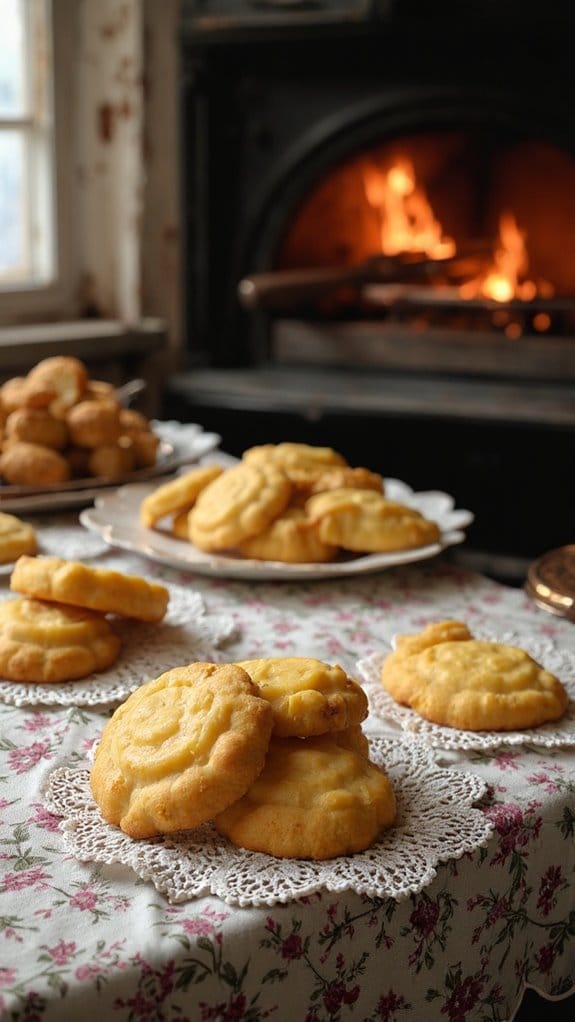
The evolution of cookies in America is deeply intertwined with European baking traditions that shaped their development. Think about it: cookies as they’re understood today trace their roots back to the 7th century in Persia, where sugar was first cultivated. By the 14th century, this sweet wonder made its way to Europe through trade, and aristocrats began tweaking cookie recipes to match their refined palates. Each country put its spin on cookies, creating a delightful variety that you can still taste today.
Now, let’s not forget the Dutch influence. When Dutch settlers arrived in New Amsterdam in the 1600s, they brought along their cookie recipes. The term “cookie” actually comes from the Dutch word “koekje,” meaning “little cake.” These settlers introduced simple butter cookies, which closely resembled English teacakes and Scottish shortbread. Can you imagine the warm, buttery aroma wafting through the air? Interestingly, the introduction of cookies to America by settlers helped establish a foundational recipe that paved the way for future innovations. This connection to early recipes mirrors the way sugar cookies evolved, as they became a staple in U.S. holiday celebrations and were often decorated with colorful icing and sprinkles, showcasing their cultural significance.
British contributions also played a significant role in cookie evolution. Shortbread, born from leftover bread dough in Scotland, became richer with the addition of butter. The British sugar trade made sweetening these cookies easier, leading to the creation of popular varieties that graced aristocratic tables.
As you reflect on these delicious origins, consider how regional flavors and local ingredients added unique twists to European baking. Each cookie tells a story, connecting us to a sweet tradition that spans continents and centuries. Isn’t it fascinating how our favorite treats carry such rich histories?
Adaptation in Colonial America
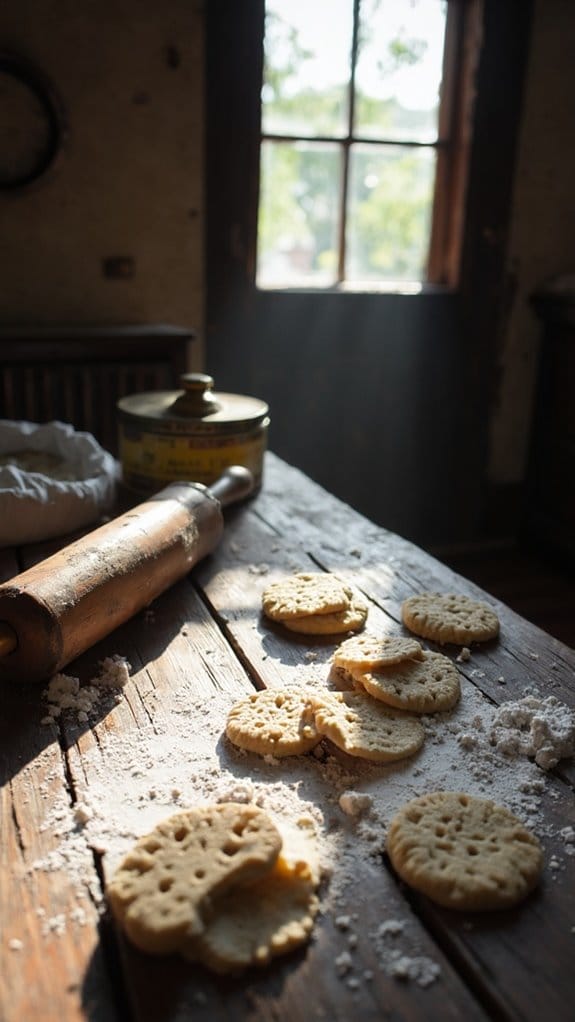
With diverse immigrant communities arriving to the New World, cookie recipes began to evolve, reflecting the rich tapestry of cultural influences. Picture Dutch, English, and Scotch immigrants bringing their beloved cookie traditions, only to find themselves adapting recipes to suit their new environment.
You see, the availability of ingredients played a huge role in these colonial adaptations. Sugar was a luxury, used sparingly, while butter became a star ingredient, often replacing other fats like lard. This shift echoes the historical significance of shortbread’s evolution, which emphasized the use of high-quality butter for a richer taste. Additionally, the commercialization of baking in the 19th century introduced new techniques that further refined cookie recipes.
As folks experimented, they turned to local ingredients like oats, fruits, and spices. These substitutions not only made cookies more accessible but also infused them with regional flair. Can you imagine the sweet aroma of cinnamon and nutmeg wafting through northern kitchens, while southern colonies delighted in fig cookies and jam-filled treats? Each region developed its own unique cookie traditions, showcasing the creativity that flourished in the face of ingredient scarcity.
Baking techniques, too, evolved over time. Early American recipes simplified the process due to limited tools and knowledge. But as baking powder and baking soda made their way into kitchens, the texture and flavor of cookies improved dramatically.
Cookie cutters became all the rage, turning ordinary dough into delightful shapes. Isn’t it fascinating how these colonial adaptations laid the groundwork for the butter and sugar cookies we enjoy today? Each bite carries a story, a blend of cultures, and a touch of freedom that reflects the spirit of the times.
Butter Drop Do Cookies
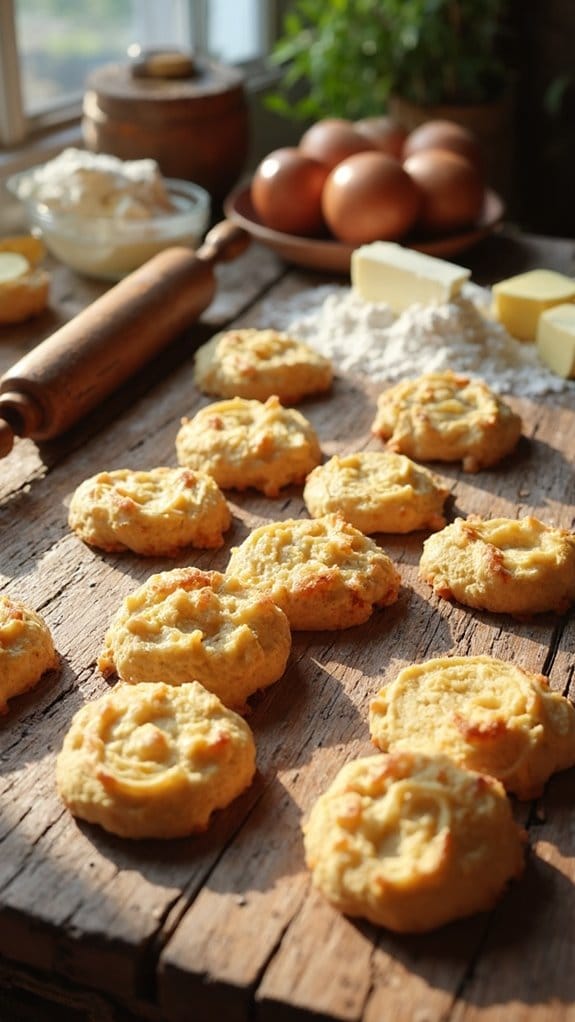
Originating from Amelia Simmons’ groundbreaking cookbook *American Cookery*, Butter Drop Do cookies have a special place in American culinary history. Published in 1796, this pioneering collection reflects the early American spirit of independence and creativity. The original recipe includes a substantial amount of butter, a pound of sugar, and a hint of mace—ingredients that come together to create a simple yet delightful treat.
As you immerse yourself in these cookies, you might notice they’ve evolved over time. While the original recipe produced delicate cakes, modern adaptations have transformed them into soft, chewy delights you know and love. This adaptation is a testament to the lasting legacy of the first known American cookbook.
You can whip up a batch using just half a cup of butter, one egg, and some flour, plus a splash of vanilla for that extra kick. Speaking of kicks, why not experiment with different butter variations or flavor combinations? Lemon zest and ginger add an invigorating twist that’ll make your taste buds dance!
When it comes to baking, remember to cool your cookies before removing them from the tray—nobody wants a crumbly mess!
Plus, they’re versatile when it comes to storage; leave them at room temperature or pop them in the fridge for a cool treat later.
Evolution of Cookie Recipes
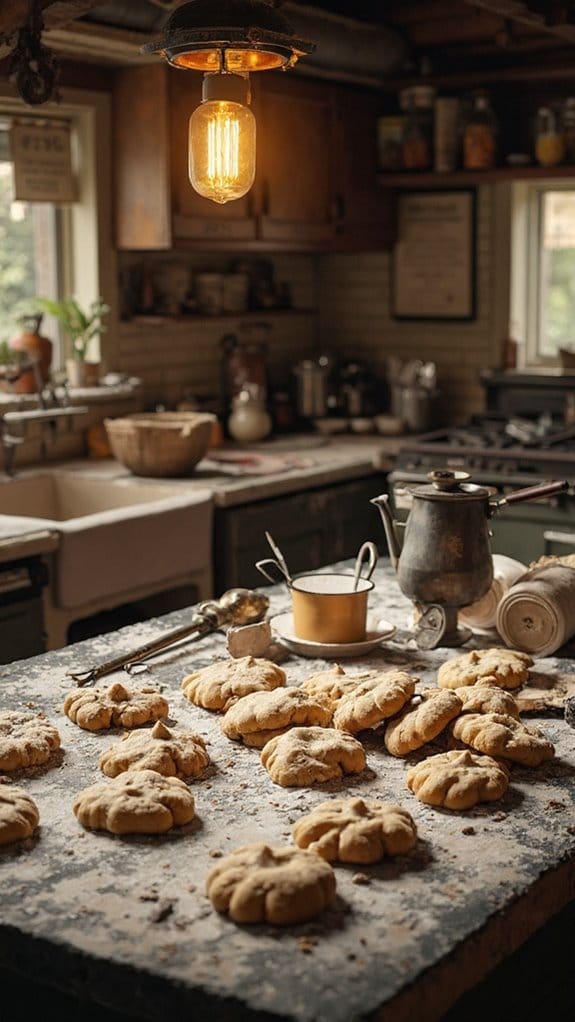
Cookies have undergone a fascinating evolution since their inception, shaped by cultural exchanges and advancements in ingredients. You might be surprised to learn that cookies trace back to 7th century Persia, eventually making their way to Europe and then to America thanks to Dutch settlers. This journey not only introduced the word “cookie,” derived from the Dutch “koekje,” but also laid the groundwork for the cookie textures and flavors we enjoy today.
As sugar became more accessible in the 18th and 19th centuries, cookie recipes flourished. You could find delightful variations like sugar cookies, gingerbread, and shortbread popping up in homes across America. These treats weren’t just for dessert; people loved pairing them with tea or coffee, making them a cozy staple in family life. With a higher butter content, butter cookies became a popular choice due to their ability to hold shape during baking, making them ideal for festive occasions. The introduction of chocolate chip cookies in the late 1930s further diversified the cookie landscape, inspiring countless adaptations and variations.
Fast forward to the 20th century, and the Great Depression and World War II sparked an increase in home baking. Amidst the chaos, cookies became an affordable source of comfort, with flavor innovations like peanut butter cookies taking the stage.
Today, the cookie landscape is more diverse than ever. From classic chocolate chip cookies to gourmet flavors like salted caramel and matcha green tea, your taste buds are in for a treat. With so many recipes and easy-to-find ingredients, the freedom to create your own cookie masterpiece is just a whisk away.
Impact of the Industrial Revolution
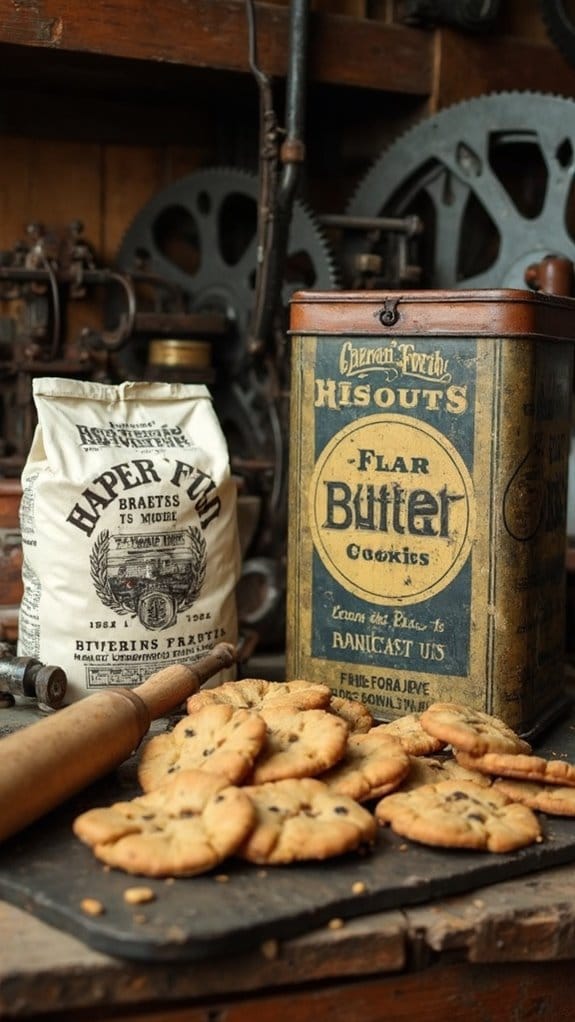
During the Industrial Revolution, significant technological advances transformed the landscape of food production, including baking practices. You might wonder how industrial machinery could change something as simple as butter cookies. Well, the introduction of machines like the steam engine and electric generator made it easier to mass-produce baked goods, allowing bakers to innovate like never before.
The invention of the refrigerator meant ingredients could be stored longer, ensuring your cookies were always fresh and delicious.
Moreover, the emergence of railroads and locomotives revolutionized food distribution, making it possible to get flour and sugar from far-off lands. Imagine being able to bake cookies with exotic ingredients that weren’t available before!
These changes also shifted the focus from small-scale baking to larger factories, which meant a wider variety of baking innovations were possible. As urban centers grew, so did the demand for convenience foods, pushing bakers to adapt and create quicker, easier recipes.
However, it wasn’t all sweet. While big corporations flourished, small local bakers faced challenges, and many lost their traditional ways of baking. With the rise of industrial food production, some of that lovely artisanal touch faded away.
But don’t let that get you down! The innovations of this era laid the groundwork for the butter cookies we enjoy today. So, the next time you bite into a cookie, think about the journey it took to get there—thanks to the Industrial Revolution!
Mass Production of Cookies
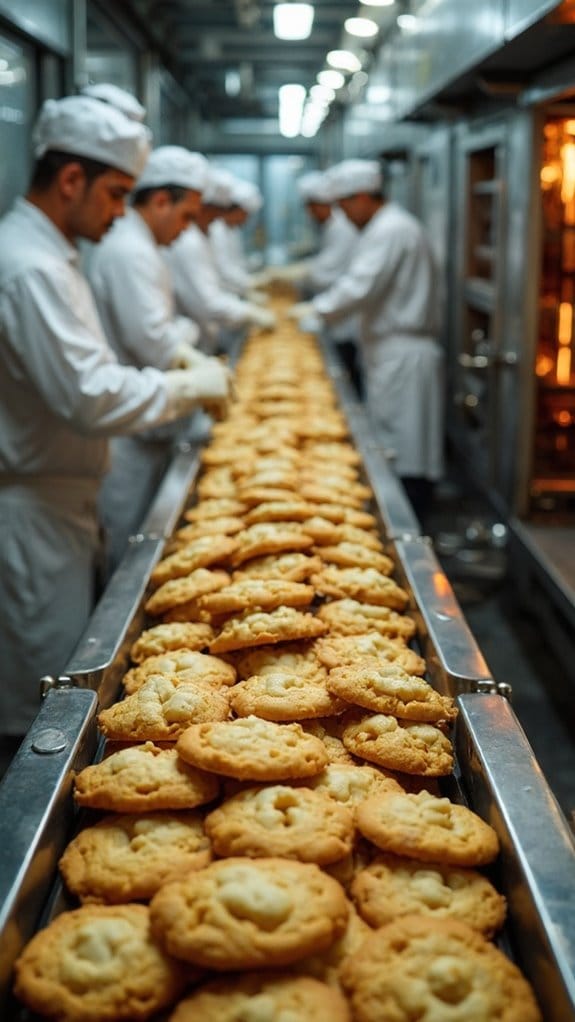
The evolution of baking practices set the stage for the mass production of cookies, fundamentally changing how these treats reached consumers. With innovations in cookie manufacturing and baking technology, the once-humble cookie became a staple in households everywhere. You might be surprised to learn how early advancements shaped this beloved snack.
| Early Innovations | Technological Advances |
|---|---|
| Invention of the biscuit tin (1831) | Introduction of electric refrigerators (1930s) |
| Establishment of cookie companies | Refrigerated cookie dough invention (1931) |
| Standardization of recipes | Automated baking systems |
| Improved packaging | Mechanized mixing |
The decorative biscuit tin by Huntley & Palmers made it easy to export cookies globally, while companies like McVitie’s and Carr’s began mass-producing these treats. Standardizing recipes guaranteed that every bite tasted just right, making cookies accessible to all.
As technology advanced, electric refrigerators popularized icebox cookies, and refrigerated dough in tubes simplified the baking process. Automated baking and mechanized mixing increased production, allowing cookies to fly off shelves faster than ever.
This boom meant cookies became more affordable, creating a sweet freedom for consumers. With grocery stores stocking these delightful bites and advertising campaigns targeting families, it’s no wonder cookie cravings soared. The cookie industry not only transformed our kitchens but also contributed to economic growth and job creation. So, next time you bite into a cookie, consider the journey it took to get there!
Cultural Significance of Butter Cookies
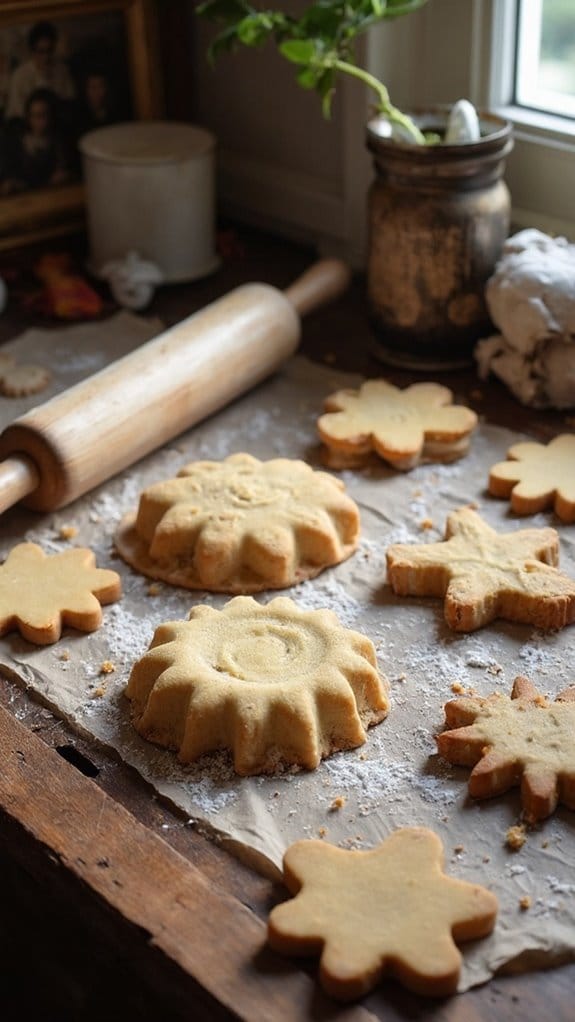
From family gatherings to festive celebrations, butter cookies hold a special place in many cultures, weaving together nostalgia and community. Have you ever noticed how these delightful treats pop up during holidays and parties? It’s no coincidence! Butter cookies symbolize warmth and hospitality, making them a staple in various cultural rituals.
These cookies aren’t just tasty; they represent a link to our heritage. Think about it: the traditional recipes passed down through generations evoke feelings of comfort and connection. When you bite into a butter cookie, you might just recall childhood memories of baking with family or enjoying them at social gatherings. They’re often exchanged as gifts, bringing people together and fostering communal bonding.
Across the U.S., butter cookies take on unique regional flavors, influenced by local culinary traditions. Each variation tells a story, showcasing how different ingredients and baking methods can create something special. Whether it’s a classic Danish butter cookie or a localized twist, these variations remind us of the beauty of cultural integration.
You can find butter cookies featured in literature and media, too. They often symbolize comfort and nostalgia, making appearances in movies and children’s books.
These little cookies have a way of reminding us of home and tradition, don’t they? So next time you savor a butter cookie, take a moment to appreciate its cultural significance and the connections it fosters among us all.
Family Traditions and Recipes

Many families cherish the tradition of baking butter cookies together, creating a warm atmosphere filled with laughter and shared memories. As you gather in the kitchen, the scent of melted butter and sugar wafts through the air, sparking joy and nostalgia. You might find yourself reminiscing about the generations before you, each adding their touch to the process.
Here are some ways family traditions and recipes come together:
- Generational Involvement: Everyone plays a part—from the youngest rolling dough to the oldest sharing stories of how it was done years ago.
- Adaptation of Recipes: You might notice how a beloved recipe has evolved, with new ingredients or techniques introduced by fresh faces in the family.
- Hands-on Learning: Each session becomes a lesson, as you mentor the little ones on the magic of measuring and mixing, keeping the tradition alive.
- Sharing and Gifting: After all the hard work, those cookies don’t just stay at home. You share them at family gatherings or gift them to friends, strengthening community bonds.
Baking memories are made with every batch, and it’s these moments that turn simple recipes into cherished family heirlooms.
Enduring Popularity of Butter Cookies
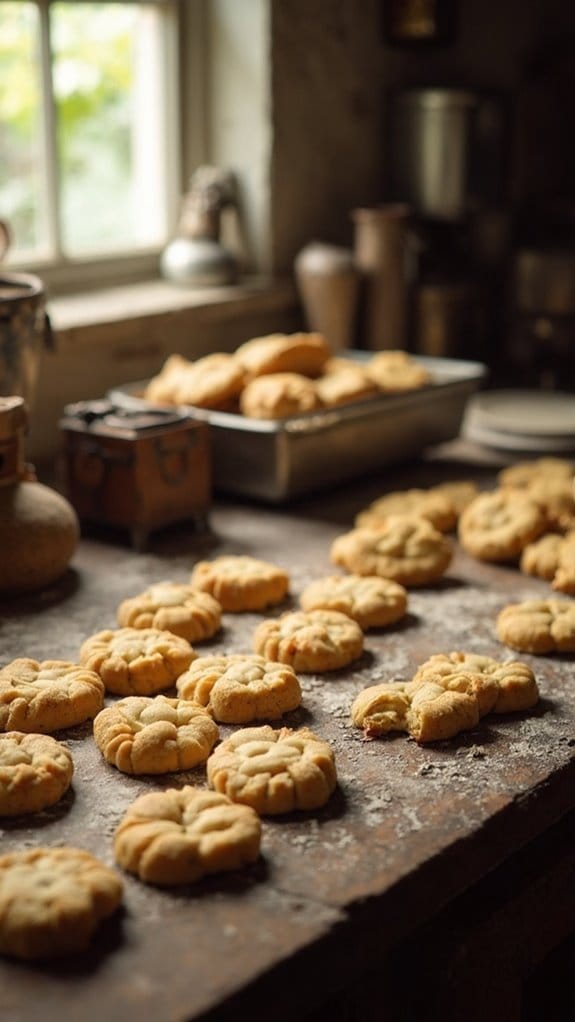
There’s no denying that butter cookies have carved out a special place in the hearts and kitchens of people worldwide. Their enduring popularity stems from a blend of nostalgic flavors and modern butter cookie trends that resonate with many.
Whether you’re rummaging through a family recipe book or scrolling through an online store, these delightful treats beckon you with their buttery goodness.
Why do you think butter cookies have such a lasting appeal? Maybe it’s their versatility. They fit right into busy lifestyles as quick, grab-and-go snacks.
With global market growth expected to hit $62.2 billion by 2032, it’s clear that folks crave the convenience and decadence these cookies provide. And let’s not overlook the health-conscious angle—many see butter cookies as a better option compared to other sugary snacks.
In Europe, where over 35% of the butter cookie revenue is generated, people savor these treats as symbols of comfort.
Meanwhile, in North America, the expanding availability in grocery stores and online shopping has made it easier than ever to indulge.
Even in the Asian Pacific, rising incomes and a love for convenient meals are boosting demand.
With each bite, you’re not just enjoying a cookie; you’re experiencing a sweet tradition that transcends borders and generations.
Frequently Asked Questions
What Are the Key Ingredients in Traditional Butter Cookies?
When you whip up traditional butter cookies, you’ll want to focus on key ingredients like butter and flour.
The butter ratios are essential for that rich flavor, while flour gives them structure.
Want flavor variations? Try adding brown sugar or a splash of vanilla extract!
Don’t forget a pinch of salt; it balances the sweetness perfectly.
With these essentials, you’re well on your way to cookie heaven—what’s not to love?
How Do Butter Cookies Differ From Other Cookie Types?
Imagine biting into a cookie that’s like a warm hug—this is butter cookies for you!
They differ from others mainly in cookie texture and flavor profiles. With a buttery richness and slightly higher sugar, they’re softer and more flavorful than shortbread’s crumbly nature or sugar cookies’ sweetness.
Want to impress at your next gathering? Roll, cut, and decorate butter cookies; their versatility makes them a delightful choice!
What’s your favorite cookie to bake?
Can Butter Cookies Be Made Without Gluten?
You can whip up delicious butter cookies without gluten using gluten-free substitutes like a good flour blend, such as Bob’s Red Mill or a homemade mix of rice flour and tapioca.
Ever tried xanthan gum? It helps with texture if your flour blend doesn’t include it.
Just mix your ingredients as usual, and you’ll have cookies that are just as buttery and delightful.
Why not give it a shot? Your taste buds will thank you!
What Is the Best Way to Store Butter Cookies?
To keep your butter cookies fresh and delicious, store them in airtight containers.
This helps maintain cookie freshness and prevents them from becoming stale. You might even want to add parchment paper between layers to avoid sticking.
If you’re feeling adventurous, consider freezing them in resealable bags for longer storage! Just remember to cool them completely first.
Isn’t it nice to know your treats can last a bit longer?
Are There Vegan Alternatives to Traditional Butter Cookie Recipes?
Imagine a friend hosting a vegan bake sale, using plant-based options to whip up delicious cookies.
You can easily swap traditional butter with vegan substitutes, like coconut oil or vegan butter, for that same delightful taste.
Add a flax egg instead of regular eggs, and toss in some vegan chocolate chips.
With these simple changes, you’ll create cookies everyone can enjoy, proving that vegan alternatives can be just as tasty and satisfying!
Conclusion
So, next time you bite into a buttery cookie, think about all the history packed into that delicious treat. Isn’t it fascinating how these simple cookies have woven their way through our culture and kitchens? With every crumb, you’re not just tasting sweetness; you’re savoring a tradition that’s evolved over centuries. What’s your favorite cookie memory? Maybe it’s time to whip up a batch and create a new one, keeping this sweet legacy alive in your own home.
